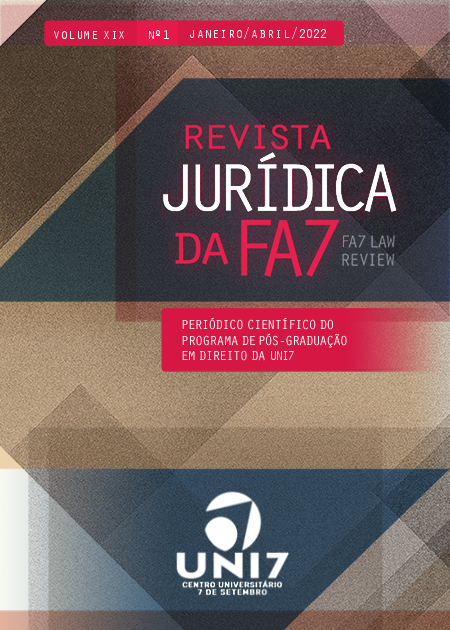The anthropic action paradox: human being as a causer of forest destruction and climate change and creator of artificial intelligence to reduce harmful effects
DOI:
https://doi.org/10.24067/rjfa7;19.1:1287Keywords:
Anthropic action, Artificial intelligence, Climate changes, Nature, Socio-environmentalismAbstract
The research problem asks how artificial intelligence can contribute to the reduction of climate change caused, among other factors, by the destruction of forests by humans. The general objective is to analyze the contribution of artificial intelligence in favor of the reduction of climate changes caused by several reasons, among them the forest destruction, taking into account that the human being at the same time that creates important technological innovations cannot manage the adequate use of natural resources. The first specific objective is to identify whether artificial intelligence is capable of contributing to the reduction of climate change. The second specific objective is to demonstrate how the human being is not sensible when harming forests. As for the research methods, the textual language is put through a systematic reading. The deductive method is used. This research is classified as basic. It is an exploratory analysis. Finally, with regard to technical procedures, this is a bibliographic search. It is concluded that the human being can create machines and invest in artificial intelligence, but needs to contribute to the reduction of climatic changes by ceasing harmful anthropic interference, with an emphasis on mitigating the destruction of forests. Thus, artificial intelligence is an important technology, which must be added to the standardization, which regulates human activities, including punishing harmful attitudes to the environment. In addition, there is an urgent need to stimulate environmental and consumer education so that there are better conditions for the possibility of achieving a better future.
References
BRANCO, Samuel Murgel. O desafio amazônico. São Paulo: Moderna, 1989.
CABRAL, Guilherme Sorg. Análise do PLS nº 5051/2019 – regulação do uso da inteligência artificial no Brasil. Disponível em: https://www.academia.edu. Acesso em: 4 mar. 2020.
CAPOZZOLI, Ulisses. Amazônia: tesouros. São Paulo: Duetto, 2008.
COELHO, Helder. Inteligência artificial em 25 lições. Lisboa: Calouste Gulbenkian, 1995.
DOW, Kirstin; DOWNING, Thomas E. O atlas da mudança climática: o mapeamento completo do maior desafio do planeta. Tradução: Vera Caputo. São Paulo: Publifolha, 2007.
EMBRAPA. Entenda a Lei 12.651 de 25 de maio de 2012. Disponível em: https://www.embrapa.br/codigo-florestal/entenda-o-codigo-florestal. Acesso em: 5 mar. 2020.
FEARNSIDE, P.M. Desmatamento na Amazônia brasileira: História, índices e consequências. p. 7-19. In: Fearnside, P.M. (ed.) Destruição e Conservação da Floresta Amazônica, Vol. 1. Manaus: INPA, 2020.
GOMES, Dennis dos Santos. Inteligência Artificial: Conceitos e Aplicações. Revista Olhar Científico – Faculdades Associadas de Ariquemes – V. 01, n.2, Ago./Dez. 2010.
GREENPEACE BRASIL. Amazônia sob ataque: queimadas têm aumento de 145% em 2019. 20 de agosto de 2019. Disponível em: https://www.greenpeace.org. Acesso em: 4 mar. 2020.
GUIMARÃES, Pompeu Paes; et al. Análise dos impactos ambientais de um incêndio florestal. AGRARIAN ACADEMY, Centro Científico Conhecer, Goiânia, v. 1, n. 1; 2014.
HELENE, M. Elisa Marcondes. Florestas: desmatamento e destruição. São Paulo: Scipione, 1996.
LUGER, George F. Inteligência artificial: estruturas e estratégias para a solução de problemas complexos. Tradução: Paulo Engel. 4 ed. Porto Alegre: Bookmann, 2004.
MEIO AMBIENTE, Ministério do. Política Nacional sobre Mudança do Clima. Disponível em: https://www.mma.gov.br/clima/politica-nacional-sobre-mudanca-do-clima Acesso em: 5 mar. 2020.
NORONHA, Matheus Eurico Soares de; RODRIGUES, José Carlos; VALENTE, Lucas Luiz Fernandes. Sustentabilidade 4.0. 8 ed. O dogmático mercado de arte. Uma crítica contemporânea em desenvolvimento. CIANTEC, 2018.
PESSIS-PASTERNAK, Guitta. Do caos à inteligência artificial: quando os cientistas se interrogam. Tradução de Luiz Paulo Rouanet. São Paulo: Universidade Estadual Paulista, 1993.
RIO GRANDE DO SUL, Assembleia Legislativa. Comissão de Saúde e Meio Ambiente. Aquecimento global: somos todos responsáveis. Porto Alegre: Assembleia Legislativa do Estado do Rio Grande do Sul, 2007.
ROLNICK, David et al. Tackling Climate Change with Machine Learning. Disponível em: https://arxiv.org/pdf/1906.05433.pdf. Acesso em: 04 mar. 2020.
SARLET, Ingo Wolfgang e FENSTERSEIFER, Tiago. Direito ambiental: introdução, fundamentos e teoria geral. São Paulo, Saraiva, 2014.
SOUSA, Nayara Machado de; FARIA, Ligia Carolina Borges. A relação do homem com a natureza e seus aspectos psicológicos na destruição e preservação ambiental. Intercursos, v. 8, n. 2, jul./dez. 2009.
TEIXEIRA, João de Fernandes. O que é inteligência artificial. E-galáxia, 2019.
WELZER, Harald. Guerras climáticas: por que mataremos e seremos mortos no Século XXI. Tradução: William Lagos. São Paulo: Geração Editorial, 2010.
Published
How to Cite
Issue
Section
License
Authors declare that
a) the contribution is original and unpublished and that it is not in the process of being evaluated in another journal,
b) they are fully responsible for the opinions, ideas and concepts emitted in the texts;
c) authorize the editors of FA7LR to make textual adjustments and adequacy of the article to the norms of publication;
d) in case of acceptance, FA7LR holds the right of first publication, under CreativeCommons Attribution-NonCommercial-Share-Alike 4.0 International license.
The authors remain with the reproduction, in whole or in part, with the necessary recognition of the initial publication, either for exclusive distribution or for online distribution, for non-commercial purposes, and the same license rules are guaranteed.









